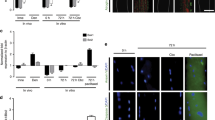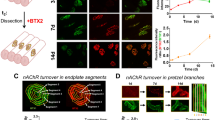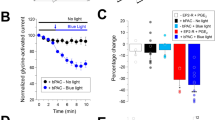Abstract
AMANTADINE hydrochloride (1-adamantanamine hydro-chloride, Symmetrel) is an antiviral agent which prevents certain viruses from penetrating cells1–3. In addition, this drug is also effective in relieving clinical symptoms shown in parkinsonism4–8 this action of amantadine may depend on its capacity to increase the synthesis and release of dopamine from dopaminergic cells of the basal ganglia9,10. To obtain additional evidence which might aid in explaining these remarkably diverse effects of amantadine, we used single-cell electrophysiological techniques to study its action on junctional and extrajunctional membranes. Our results show that amantadine, in clinically effective concentrations, rapidly inhibits neuromuscular transmission, and when applied over a longer period of time the drug also exerts a substantial effect on the conductile membranes of muscle fibres.
This is a preview of subscription content, access via your institution
Access options
Subscribe to this journal
Receive 51 print issues and online access
$199.00 per year
only $3.90 per issue
Buy this article
- Purchase on Springer Link
- Instant access to full article PDF
Prices may be subject to local taxes which are calculated during checkout
Similar content being viewed by others
References
Davies, W. L., et al., Science, 144, 862–863 (1964).
Hoffman, C. E., Neumayer, E. M., Haff, R. F., and Goldsby, R. A., J. Bact., 90, 623–628 (1965).
Maassab, H. F., and Cochran, K. W., Science, 145, 1443 (1964).
Schwab, R. S., England, A. C., Jr., Poskanzer, D. C., and Young, R. R., J. Am. med. Ass., 208, 1168–1170 (1969).
Parkes, J. D., Calver, D. M., Zilkha, K. J., and Knill-Jones, R. P., Lancet, i, 259–262 (1970).
Millac, P., Hasan, I., Espir, M. L. E., and Slyfield, D. G., Lancet, i, 464 (1970).
Appleton, D. B., Eadie, M. J., and Sutherland, J. M., Med. J. Aust., 2, 626–629 (1970).
Dallos, V., Healthfield, K., Stone, P., and Allen, F. A. D., Br. med. J., 4, 24–26 (1970).
Grelak, R. P., Clark, R., Stump, J. M., and Vernier, V. G., Science, 169, 203–204 (1970).
Scatton, B., Cheramy, A., Besson, M. J., and Glowinski, J., Eur. J. Pharmac., 13 131–133 (1970).
Nastuk, W. L., and Alving, B. O., Biochem. Pharmac., 1, 307–322 (1959).
Author information
Authors and Affiliations
Rights and permissions
About this article
Cite this article
NASTUK, W., Su, P. & DOUBILET, P. Anticholinergic and membrane activities of amantadine in neuromuscular transmission. Nature 264, 76–79 (1976). https://doi.org/10.1038/264076a0
Received:
Accepted:
Issue Date:
DOI: https://doi.org/10.1038/264076a0
This article is cited by
-
Recent Clinical Advances in Pharmacotherapy for Levodopa-Induced Dyskinesia
Drugs (2019)
-
Motor-learning Impairment by Amantadine in Healthy Volunteers
Neuropsychopharmacology (2004)
-
Forskolin blocks carbachol-mediated ion-permeability of chick myotube nicotinic receptors and inhibits binding of 3H-phencyclidine to Torpedo microsac nicotinic receptors
Naunyn-Schmiedeberg's Archives of Pharmacology (1987)
-
Amantadine antagonism of oxotremorine effects
Journal of Neural Transmission (1979)
Comments
By submitting a comment you agree to abide by our Terms and Community Guidelines. If you find something abusive or that does not comply with our terms or guidelines please flag it as inappropriate.



